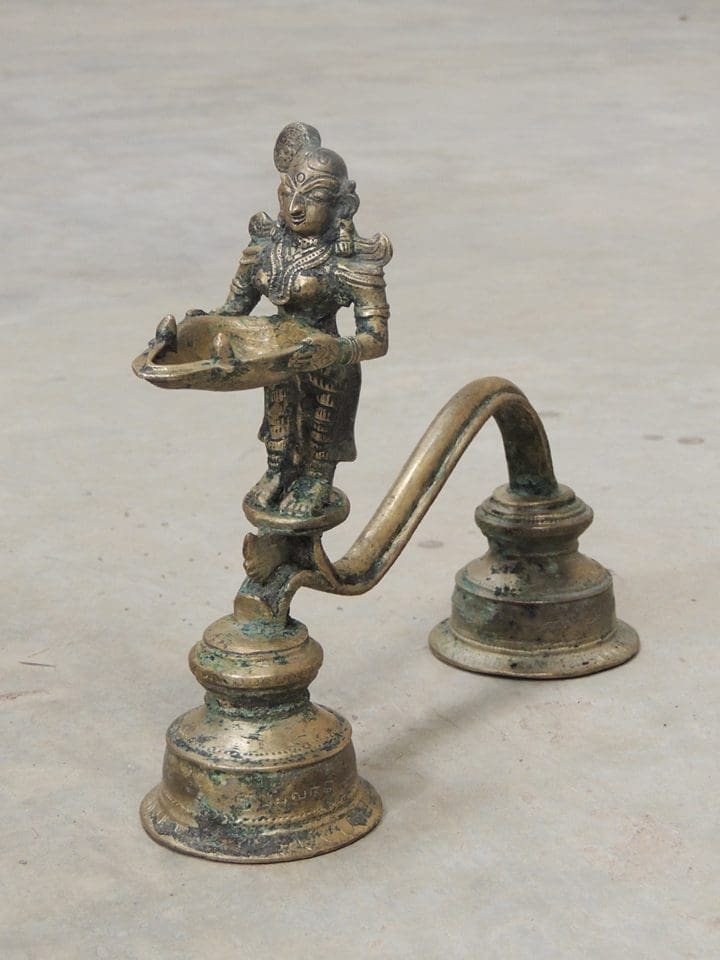
It is not that the lamps were only used for ritual purposes. Before the advent of electricity, the oil lamps were widely used all over India for sacred as well as secular purposes. It was an essential object for all classes of the society and therefore, an inexhaustible variety of lamps ranging from a simple earthen bowl to the most elaborately fashioned structure-incorporating hundreds of lamp bowls in its design came into existence.
Arati lamps
Arati is an invocation of a deity, done with the accompaniment of lamp and music. In such a ceremony, the lamp is held in one or both the hands and waved repetitively in front of an image or any installation of a deity. Provision of a handle and an even base (to be able to place on the floor) are the two basic features of an arati lamp. The arati lamps are usually made of brass, but sometimes of other alloys or of copper or silver. An arati lamp has sometimes one, but often multiple lamp bowls. The handle of such a lamp is sometimes in the shape of a simple curve, sometimes a creeper with flower and foliage, sometimes a cobra with multiple and expanded hoods, sometimes a peacock with elongated tail, sometimes embellishment with a nandi.

In some arati lamps, there is a single lamp bowl, but in most, there are multiple cavities arranged in one straight line or in a semi-circle or in several tiers of rows of lamp bowls. The cavities are comparatively small, because the ritual of arati lasts only a few minutes. In most arati lamps the lamp bowls are attached to or are a part of a semi-circular tray, but occasionally these are attached to the figure of an elephant a peacock, a cobra etc. in some cases the lamp bowls are shown being carried by human or celestial figure.
Standing lamps
Average standing lamps consist of the central staff divided into several rims and tiers having a broad base and a lamp plate or lamp bowl on top. The staff usually consists of combinations of bell-shaped or inverted bell-shaped parts, tapering tiers, balls, rims etc. in some cases lamp bowls or circular lamp plates with extended multiple wick channels are fixed to the stem of the lamp. Occasionally the stem of the standing lamp consists of a peacock, a parrot or a flower bud. In most cases a circular plate having multiple wick channels and oil cavities surmounts a standing lamp.
In most cases the lamp plates containing ghee or oil are open, but in some cases, a perforated lid with a crowning peacock covers the lamp, so that the moths might not fall into the liquid.

The ornamentation of the stem of the standing lamps has led to the development of another class of lamps called ‘vriksha deepa‘, or tree lamps. In such lamps ornate branches are shown shooting out from the tiers of the stem at a regular distance. Each branch culminates into a flower-shaped lamp plate, each of which contains several wicks. When fully lit, such a lamp gives a rich festive touch to the entire atmosphere of a temple or a house with its hundreds of small lights.
Dipika or Deepalakshmi type of lamps forms still another class of the standing lamps. Here a standing woman holding both her hands a large lamp bowls replaces the central stem of the lamp. The lamp is in the form of a celestial attendant of light. A woman is considered to be the incarnation of Sri or Laksmi and therefore the lamp in the form of a woman carrying light is, not surprisingly, designated in the popular terms as Deepalakshmi or Lakshmi with a lamp.
 Hanging lamps
Hanging lamps
And entire class of lamps to be suspended from the ceiling seems to have been very popular from early times. Such lamps are in the form of an ornate lamp bowl at the bottom and a chain above. The lamp bowl itself is sometimes an ornate cup embellished with an arch decorated with flowers and birds, or in the form of a square or circular wick plate surmounted by a huge metal chakra, a wheel, with flames issuing from the rim, or just a hollow figure of a bird with a wick channel either issuing from the head, or from a cup placed underneath the bird.
Miscellaneous lamps
Some lamps are devised specially for a certain sectarian group or a worshipper in which case, the image of a certain deity such as Ganesh, Hanuman, Siva, Vishnu are incorporated in any of the parts of the lamp. Attaching wheels at the base of the lamp construction creates sometimes-mobile lamps.

Be the first to comment